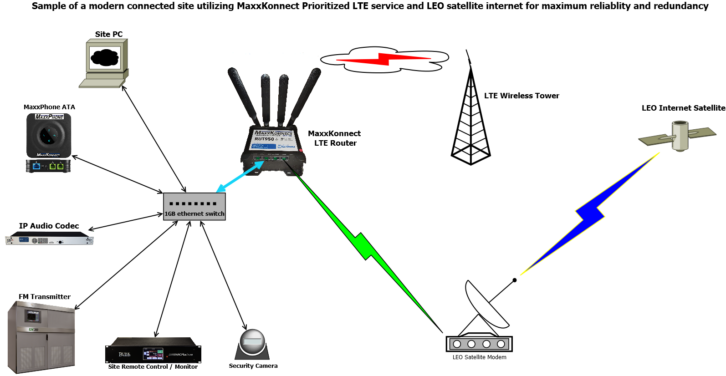Connectivity is right in the name of Josh Bohn’s growing company. He’s president and CEO of The MaxxKonnect Group, a broadcast technical firm. One of its products is MaxxKonnect Wireless, a prioritized, high-speed LTE internet service for broadcast applications. Bohn has also worked as an engineer for companies like Radio One, Main Line Broadcasting, Cumulus and what was then Clear Channel.
This interview is from the ebook “STL in the 21st Century.”
Radio World: What jumps into your mind when I ask about the state of STL?
Josh Bohn: The proliferation of IP as an STL has become the de facto standard. We’ve sold maybe three point-to-point 950 MHz STLs, analog or digital, in the last two years. That’s it. And fixing Marti and Moseley point-to point STLs used to be the majority of our business, but in the last year, we might have done eight where we used to do five or six a month.

We plan to launch an analog 950 STL after NAB. It’s got composite mono natively, but you can do stereo left/right through it or AES. It will have a Web interface on both ends with SNMP and browser-based interactions — to change frequency, change the power, turn it on and off. The SNMP will let you marry it to your remote control, so you can monitor what your receiver’s doing. Legacy analog products didn’t have that.
Major and large markets might not be using 950 STLs anymore but go into smaller markets and they’re still running legacy 950 STLs. There’s a need for something that can be monitored with IP, something they can plug their composite cable into, hook the antenna up, plug it in and it’s on frequency. Then they can go back to running “Swap Shop” and the funeral report, because that’s where they make their money.
RW: Do you have STL words of wisdom?
Bohn: I’m a huge advocate of backups. I got a call an hour ago from a station in Tennessee, a community college that’s talking to us about moving to a tower about 10 miles away. I asked what they use now for STL, and he said it’s point-to-point 950 microwave, analog composite. But the electric co-op that’s building the new tower is putting in fiber in so they’re going to go on that.
But what are they going to do when the North American Fiber-Seeking Backhoe comes and takes them off the air for two days? If you’re going to do fiber with point-to-point IP, even over the internet, your codec will have the ability to fail over. So whether we put a MaxxKonnect cellular modem or point-to-point IP radios, or if we can get a 950 shot we can relicense their current STL and just put in a composite switch, you’ve got to have a backup.
People hear “fiber” and think all their problems are solved. Yes, fiber is super reliable — until it’s not. If it’s buried, you have to worry about “backhoe fade,” though that’s maybe the only major thing. But if it’s aerial fiber? A drunk driver, an ice storm, a windstorm, almost anything external can destroy it. If a pole falls, it’s going to shred whatever’s connected to it, which includes your fiber. And that’s a significant amount of downtime.
We have a client site with MaxxKonnect. They had fiber running into their building. But a housing development is going up across the road, and a plumbing crew came in. They didn’t call 811 first, and they cut through the entire bundle. That station had a T1 backup, but the fiber and the T1 run through the same conduit. So in one scoop, all connectivity for that site went down. They were off the air, in a big market in Ohio.
But their chief was smart, he also had Comrex BRIC-Links hanging on MaxxKonnect. So they were only down for the amount of time it took him to drive out, unplug the audio out of the out of the T1 codec, move it over and plug it into the output of those BRIC-Links, and boom, they were back up.
They ran on that for four days and ultimately ended up ditching the T1 and just switching over and using MaxxKonnect and BRIC-Links as their backup.
So figure out two ways to get program audio there. I don’t care if you string a piece of wire a quarter mile down the road (though if you do that, put transformers on each end).
If you’re doing IP, consider your studio too. You may have three backup connections at the tower site, you may have an LTE modem, DSL and an internet fiber connection, but you have only 10 Gig fiber at the studio. Why is fiber at the studio good enough while fiber at the transmitter needs backups? People get a false sense of security because the studios are in a town and they think the infrastructure is more stable there. But there’s just as much of a chance for your IP delivery system to get knocked out in an urbanized area than out the transmitter.

RW: Who does the fiber work, and can you share tips for working with them?
Bohn: It’s from a carrier-level provider, whether it’s AT&T or a company like C Spire out of Mississippi, or Lumen or Verizon.
Bigger groups like iHeart have moved completely to IP STLs. When iHeart goes in and rebuilds their markets with those four-studio models, where everything’s multipurpose, there is no RF in or out of those buildings anymore, not even satellite dishes. They’re delivering all their network content via IP, and that’s where everything is going.
Again, you’ve got to have multiple ways of delivering the audio, otherwise you run the risk of being off the air. There are so many external factors. All of this is riding the public internet at some point. You’re using public infrastructure, not a transmit dish and receive dish with a path 400 feet in the air. You’re going through God knows how many switches and LATAs, crossing between providers, from this mux to that mux. The points of failure have gone from two to as many as 50, most of which you have zero control over.
So the only way you really have control over your broadcast is to have another way to deliver it.
Some people want to use our service as a primary STL. That’s great, but get two different carriers — and point their antennas at different towers. You might think “Hey, I’ve got three carriers on my tower,” so you’re not worried about it; but if all three carriers are on your tower, they’re riding the same fiber bundle. You can take your primary off there, the signal is going to be great; but for your secondary, get a directional antenna and point it at a tower three miles down the road. Then if yours goes down, it will pick that one up, and you won’t have a hard off.
Of course, everything is subjective. If you’ve got a station that makes $5,000 a month in the middle of nowhere in Mississippi and another station in a major metro that’s making $60,000 a month, which one gets the backup? The one in Mississippi is three hours way. But the one here in the market is making all the money, so the other one is just going to have to be off the air until we can get there.
[Sign Up for Radio World’s SmartBrief Newsletter]
RW: Is Starlink satellite part of this discussion?
Bohn: I know people that have used it. There’s a use case for LEO satellite. But it seems that it’s very location-dependent. And also time-dependent.
The Starlink system, from what I understand, is set up as a mesh, and it’s very locked down. You can connect from a downlink terminal out to a public static address on a terrestrial service, whether it’s LTE or wireline; but you can’t connect into a Starlink service, because they don’t offer public IP addresses. I believe everything is IPv6, which is why they don’t offer public addresses. Most routing equipment still can’t handle that.
We’re trying to get together a Ka band MaxxKonnect product that you could use as an STL, to go into transmitter sites where cellular may not be a good option or where cellular is the only option but you want something more robust that isn’t metered that can run full-time. But for what broadcasters need, Ka isn’t there yet; the infrastructure in the U.S. isn’t built out. I can get you Ku band service but it’s atrociously expensive.
Still, satellite is becoming more of an option. And when you say satellite internet, people think Hughes; but the average subscriber ratio for HughesNet and the commercial services is 300:1. The latency for an uplink is almost unusable. For downlink it’ll work fine, and there are people who use Hughes as an STL downlink. As long as you’re running a low-bitrate stream, it’ll work pretty well; but don’t go out there and try to browse on it.
So LEO is great, but access is a problem because you can’t use the Starlink portal to get back into your site through IP addresses. I mean, you could put a jump-box type computer in there, and get into it with ScreenConnect or LogMeIn, and then browse to your stuff at the site. But if you want to be able to directly manage your devices — if you need to connect to your Burk or your transmitter without having to jump into another computer, you’ve got to have an actual IP address; and that’s where the Starlink system currently falls short.
RW: Are broadband and radio STLs the most common types?
Bohn: Anything else is still an outlier. What we’re doing with LTE has become a lot more common, but it’s still in a distant third place to fixed wireline broadband — fiber, cable or whatever — while point-to-point radio STLs are still king because they give you full control over your link.
RW: Using IP technology on either end?
Bohn: In some cases, yes. I would lump point-to-point IP and analog into the same category, because you’re accomplishing the same thing. It’s just a difference in hardware and frequency. IP has become more prevalent in larger markets. Point-to-point links, whether licensed or unlicensed, are more common in larger markets than the analogs. But I still walk into small-market stations that are still using TFTs STLs. That’s why we’re building one ourselves; because there are lots of them out there pushing 40 years old. And when they die, they die hard.
RW: What else do you see coming?
Bohn: The overall concept will never change; it’s getting program content from one point to another. There will always be innovations and delivery options — 5G, 6G, 9G, whatever they come up with. But ultimately, we’ve moved into delivery over the public internet, and that’s where we’re going to stay for quite a while, until there’s a fundamental shift in how the internet operates.
Ten years ago, did anybody ever think that you’d be able to carry composite audio over IP? No, but Hans van Zutphen figured out how to do it in a low-bitrate package with uMPX, and it sounds phenomenal. So, will there be advances and things that are really cool? Absolutely.












